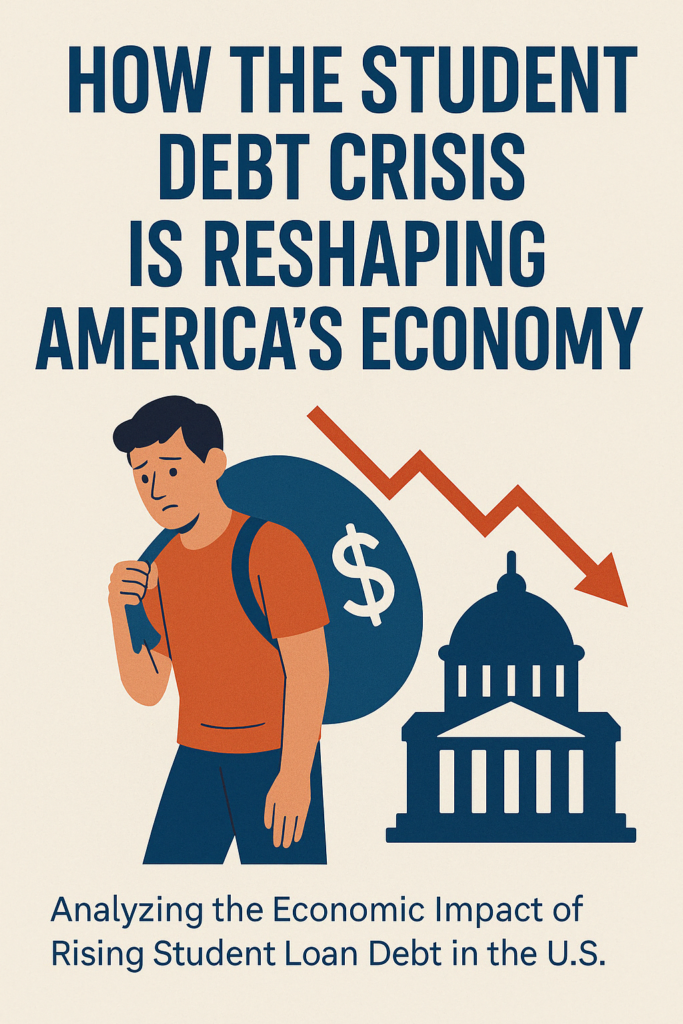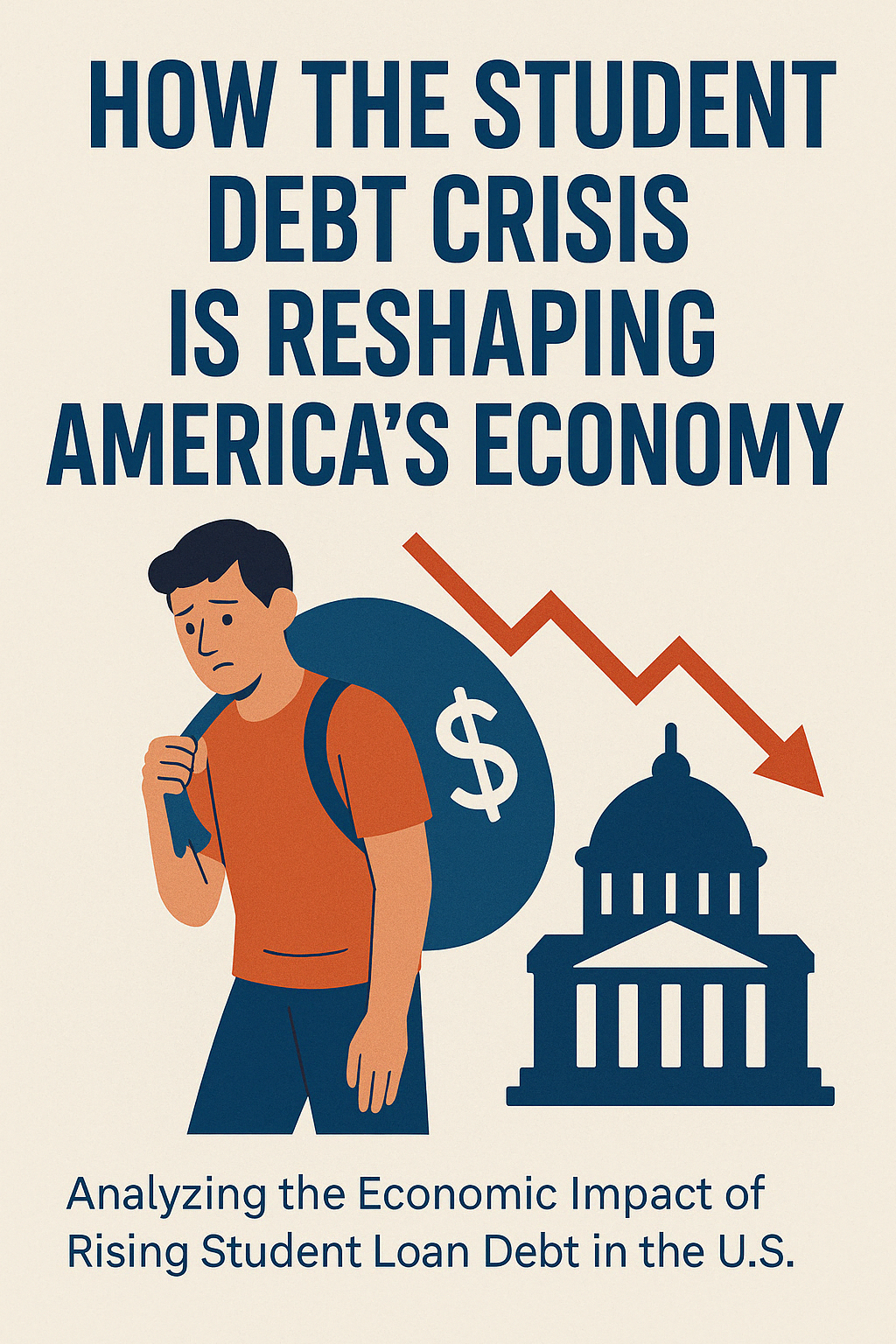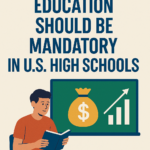Introduction
The student loan debt crisis in America is currently at an extremely worrying point. More than 43 million borrowers in the United States currently owe a whopping $1.7 trillion, and the burden of debt has escalated from merely personal struggles to a far more serious economic issue that affects the whole nation. What started as helping students gain access to higher education has now become a financial stranglehold that affects everything from getting a house to retiring.
This crisis is changing how Americans save, spend, or invest, and the very essence of the national economy. Let’s examine how student debt is not only affecting individuals but also severely hampering the economic engine of the United States.

The Increase of Student Loan Debt
The cost of college in the United States has surged irrationally in the last 30 years. Public college tuition fees have increased more than three times, while private colleges are currently raising their fees even more than that. Students have increasingly relied on loans as an option ever since wages plateaued.
The average debt at graduation in 2024 is around $37,000, while graduate school debt often exceeds more than $70,000.
Educational repayments can vary massively, hovering between $200 and more than $1,000 on a monthly basis.
With everything considered, education was deemed a surefire approach towards achieving the American dream. But now, it looks more like achieving it is going to involve decades of endless financial burdens and stress.
Postponement of Major Life Choices
The postponement of key milestones in life is one of the more noticeable impacts associated with a student’s debt. These include:
Homeownership: Millennials, along with the Gen Z population, are either not buying homes or are doing so in their late twenties. The majority of these people have a debt-to-income ratio that disqualifies them from receiving a mortgage.
Marriage and Family: The financial challenges faced by people in today’s world prompt them to postpone having children, getting married, or starting a family.
Starting businesses: The aspiring entrepreneurs who want to open their own businesses may postpone or abandon their plans because of limited capital and the burden of monthly loan payments.
A twelve-Federal Reserve study showed that student loan borrowers are 36% less likely to buy a home within seven years of graduating as opposed to those without debt.
Impact on Wealth Building
In terms of accumulating wealth, a student’s loan debt has a negative effect on:
Lower retirement savings: With having so many payments to take care of every month, a person is less likely to contribute towards their 401k or IRA, which helps in securing their future.
Less investing: Due to having lower disposable income, the younger generation is less likely to invest in stocks or real estate.
Minimal emergency savings: A borrower lives paycheck to paycheck, making them susceptible to facing severe financial problems.
In the eyes of many Americans, the student debt ails them financially, countering the advantages that a college degree brings.
A Growing Racial and Economic Divide
The crisis of student debt enhances one’s reach while amplifying the divide presented due to racial differences and discrepancies in one’s income.
Borrowers of Black descent typically owe more on their loans and take longer to pay them off. Additionally, the average Black college graduate is $25,000 deeper in debt than their white counterparts two decades after they begin repaying their loans.
Due to a lack of generational wealth, low-income families find themselves in a cycle of intergenerational debt.
Without systematic changes, policies aimed at alleviating student debt will only serve to heighten the wealth gap between racial groups and further deepen the divide among wealth inequality.
Impact on Employment
Student debt, particularly in the U.S., has altered where and how people work:
Job selection: Graduates tend to lean toward highly compensated positions rather than passion-driven jobs like teaching, public service, or art that pay significantly less.
Mobility: Borrowers tend to stay away from relocating towards areas with better jobs but higher costs of living.
Side-hustle culture: Some graduates take on part-time, side jobs merely to keep up with loan repayments.
Decisions made from debt burden available shape labor markets, wage projections, and the level of innovation in a given economy.
Debt anxiety, as previously mentioned, causes lasting sociological impact:
Depression: The persistent financial burden can affect one’s mental health.
Insomnia: Financial obligations lead to sleepless nights.
Strained relationships: Debt plays a critical role in calamitous romantic and familial relationships.
The psychological stress of student debt impacts a person’s productivity, concentration, and general well-being, resulting in more significant problems at a societal level.
Recent Changes by the Government and Economy
In the last couple of years, some policymakers have started understanding the intricacies of the student loan problem. Some recent actions taken include
Income-Driven Repayment (IDR) Plans: Payments are capped at a certain percentage, but many borrowers have a difficult time managing the payment system.
Public Service Loan Forgiveness (PSLF): Forgiveness is given after ten years of service, but approval rates tend to be much lower than what is acceptable.
Other proposals suggest forgiving anywhere from 10,000 to 10 trillion in student debt. Some relief has been provided, but a lot more still needs to be done.
Looking at the bigger picture, student loans are directly impacting consumer spending, which significantly contributes to GDP. Economists explain that if millions of Americans spend their money on repaying loans instead of putting it into circulation, the economy takes a hit. This is the reason why many economists argue about the existence of a debt crisis—it is not only a social concern but also a matter of economic stability.
Risks Related to the Economy
Failure to tackle the student debt issue may result in:
A fall in the homeownership ratio
A decrease in national savings and investments.
A weakening middle class family
Enhanced dependency on government assistance
Reduction in GDP growth
The impact does not only rest with the students; it touches on everyone in society. Financially burdensome taxes lead to higher dependency, less spending, and lower revenues. All these do not bode well for the health of the economy.
What Needs to Be Done: Solutions
To improve the current outlook narrative, aggressive reforms accompanied by the following solutions must be adopted: Rash ideas include:
Lowered or no tuition rates for community colleges: alternative methods that bridge the gap to more advanced education.
Increased support to cancel debt for wider coverage of low income: Especially public service workers.
Improve non-profit colleges supervision: Supervisors with high dropout and jobless rates should not have privatized control over their functions.
Beginning the teaching of adult financial literacy at secondary schools: Guidance to tame spending and managing funds before adults
Government issued non-interest loans: Stop loans from growing uncontrollably
Although the suggestions here will not immediately resolve the entire challenge, they will ensure that the future is morally fair and sound economically. Conclusion
The issue of student debt is arguably one of the greatest financial traps in the modern world, as its ramifications reach beyond a mere monetary concern. It is simply a matter of time before the lack of effective solutions begins to reveal itself in other areas of socio-political life. The usurpation of peripheral economic activities tends to gradually sap entrepreneurial spirit, which economically binds individuals to a debtor’s life.
To contain the repercussions, further exacerbating the financial ‘slicing’ of the multiverse, policies should be in unison at all levels, alongside unrestrained help from bipartisan expert-layman panels. As Congress cautiously moves towards solving the issue of student debt, a collective wave of relief touches the nation, and everyone begins to realize that dismantling the problem is at the heart of renewing the world’s faith in the American economy, alongside the existence of solid practical infrastructure.

SEO expert with a passion for optimizing websites and driving organic traffic through data-driven strategies.





